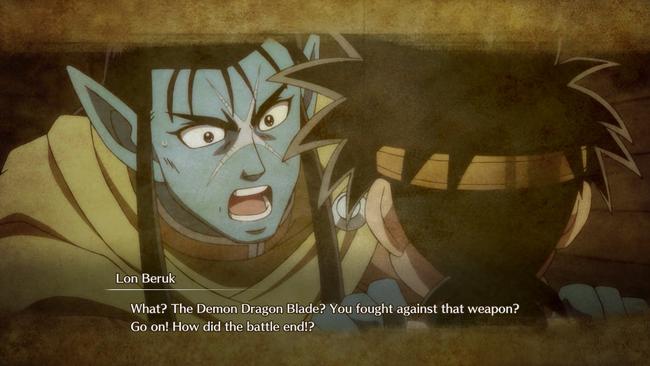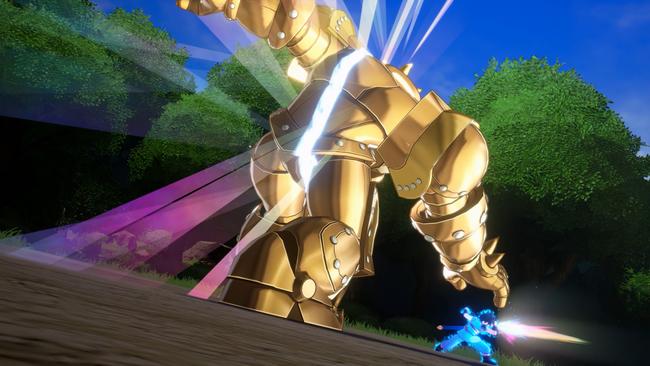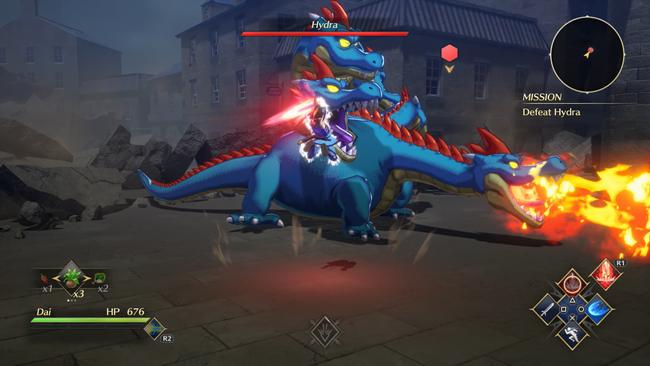
Infinity Strash: Dragon Quest The Adventure of Dai Review
I hopped on board the Dragon Quest: The Adventure of Dai train with its recent anime adaptation in 2020. Going into it, I already knew it was based on a 1989 manga, but I otherwise didn’t really know what to expect. After watching all 100 episodes, I came away from it really loving the series and its cast of characters. It made me very excited to see how Infinity Strash: Dragon Quest The Adventure of Dai would translate that experience into a video game.
I’m ripping the band-aid off early. Infinity Strash is not a good game. The title gets close to being okay at best, though its structural flaws and stiff gameplay muddy up the overall experience.

Infinity Strash is one of three multimedia projects that accompanied The Adventure of Dai’s 2020 anime adaptation; the other two were A Hero’s Bonds (a mobile game that shut down earlier this year) and Xross Blade (an arcade game). This console project is probably the one that relied the most on the anime’s development timeline though. While the other two could be continually updated over time as the anime revealed new character and monster designs, Infinity Strash needed to have a set end to give its developers enough of a lead time to release it in a timely manner that wasn’t too far off from the show’s finale in late 2022.
This reliance on the anime’s production has fundamentally crippled Infinity Strash unfortunately.
Of course, not everyone who picks up Infinity Strash will be a fan of The Adventure of Dai already. Infinity Strash has to account for newcomers who don’t know anything about its story and characters. Sadly, the game presents these in one of the most uninteresting and boring ways imaginable - through a plethora of vignettes filled with screenshots from the anime.

Players progress through Infinity Strash through stage nodes on a world map. There are main stages to progress the plot, repeatable free stages to grind characters’ levels, and story stages that play a video file of a vignette to provide people with a condensed version of what’s going on. Normally, I’d be more understanding with this approach if it was a snappy synopsis of relevant plot beats to contextualize an upcoming stage.
Instead, Infinity Strash sluggishly follows the show’s events through a massive amount of vignettes that can take up to 10 minutes straight. These vignettes are essentially still screenshots of the anime — with narration and voice over — all overlaid with an annoying film grain filter that mutes the vibrant, lively colors of the anime. These often show up in main stages too, not just story stages.
Amusingly enough, people can have a seek bar pop up on any scene in the game to gauge how long the video file has left. Players can rewind and fast-forward through them, though these immediately skip chunks of the video onto a predetermined chapter bookmark on the seek bar, rather than speeding up the video itself. So, there’s no way to speed up a lengthy vignette without missing lines.

If an individual is familiar with the story already through the manga or anime, they’re free to skip all these segments since none of what transpires is new or different. It is an accurate, and dull, retelling of The Adventure of Dai that is a depressing way to present what makes the source material itself so special.
What makes it especially sting is that some key moments of the story are fully animated with the in-game graphical engine. In these rare scenes, the visuals in Infinity Strash itself do a fantastic job adapting the energetic art direction of the show with smooth cel-shaded models. When story scenes play out with these choreographed visuals rather than a still shot vignette, it was genuinely great to see. I lament at the enormous lost potential of Infinity Strash. If it presented its story scenes with its in-game models at the cost of slimming it down to its core narrative beats, it would’ve made for a stronger game overall.
In its current form, the game simply drags on and on; players can be stuck waiting for extended periods of time before progressing the plot if they don’t fast-forward or skip the string of vignettes.

The game begins from the very beginning of The Adventure of Dai’s story at Dermline Island up till the fall of Sovereign Castle. After players defeat Sovereign Castle, Infinity Strash’s main story abruptly ends. Once again as I mentioned earlier, the development timeline of this title being so intertwined with the show is mostly to its detriment. There’s a lot of story left in The Adventure of Dai beyond Sovereign Castle, but I’m sure it had to be cut because they wanted to release this game while the Dai anime was still relatively fresh and relevant - instead of releasing this several years after it’s ended.
Throughout the journey, players meet and recruit the Disciples of Avan to form their party which includes Dai, Popp, Maam, and Hyunckel. They all possess different movesets and capabilities; a few do share the same abilities and spells, yet the way they fire them off is different. Leveling them up only raises their HP, attack, defense, and magic. Acquiring new abilities and spells is dictated by story progression.
Maam and Hyunckel do eventually gain access to another vocation that switches them to an entirely new weapon and fighting style because of events in the plot. All four Disciples of Avan get several new outfits throughout their adventure, though these only affect their appearances and nothing else.

The equipment system feels lackluster in Infinity Strash. Instead of obtaining new weapons and armor, players can equip cards called Bond Memories onto them. These provide additional stat increases and can grant additional effects, such as increasing the rate a character’s Coup de Grâce super attack meter fills.
Bond Memory cards are ranked via 1-star, 2-star, or 3-star; the higher the amount of stars, the more powerful it is. To offset this, each character can only hold a certain amount of the higher-starred cards. While the Bond Memory cards add a certain charm to Infinity Strash as they all feature artwork from the original 1989 manga, upgrading them is more cumbersome rather than exciting.
Upgrading abilities, spells, and Bond Memories is all done by interacting with the game’s Temple of Recollection roguelike mode. Early on in the main story, the Temple of Recollection opens up. Players’ levels are entirely separate from the main campaign in there, as each run will always have all characters start at level 1.

Each layer here consists of several enemy-filled rooms. Most rooms focus on slowly upgrading stats upon clearing them. A few give additional Bond Memories through a treasure chest or reward resources that are used for upgrades. Before diving into a deeper layer, the Temple of Recollection gives players the option to back out with all the items and Bond Memories they’ve collected. If they die or choose to abandon it any other way, all of the stuff they’ve collected would be forfeited instead, like a true roguelike.
Thankfully, starting another Temple of Recollection run doesn’t always have to start at the first layer. A teleporter can transport players to deeper layers they’ve reached for a small fee. New Bond Memories only appear in later layers.
Acquiring duplicate Bond Memory cards is mandatory to level them up. If people want to upgrade a specific Bond Memory card, they must collect dupes of that specific one to level it up, which can be a frustrating exercise of randomness. Each higher level requires more and more duplicates of them as well. Plus, the UI screen to level up Bond Memories can be a bit confusing in determining which cards can be leveled up. For several hours, I was convinced there was no indicator for it until I noticed that a small tiny red arrow is marked at the bottom of cards that do have the resources to be upgraded; it's not the most obvious thing that sticks out in the UI.

The Temple of Recollection pretty much reuses enemies and bosses that have been previously encountered in the main story for the most part. Additional layers are added to it as people progress further into the campaign. It does contain a few new bosses not seen in the main story in its later layers that are unlocked post-game. The primary use-case scenario for this roguelike mode is upgrading skills and Bond Memory cards if players get stuck on a difficult stage in the campaign.
As for the battle system itself, Infinity Strash simply just doesn’t feel good to play. It’s rudimentary, stiff, and clumsily executed. Each character has access to a basic attack string that has an alternate finisher by slightly delaying the third button press. Alongside that, they can guard, dash, and can equip up to three abilities or spells.
None of it flows well at all. Attack strings can’t be canceled into a guard or dash; everything is animation-locked. Skills and spells have lengthy cooldowns that can slightly be sped up by connecting basic attacks, though it’s still longer than what I would like. Very few Bond Memory cards affect cooldown rate too.

That’s why I found Popp to be the most entertaining character to play. His arsenal of magic did a crazy amount of damage and most importantly, he had the ability to vastly accelerate all his cooldown simultaneously through meditation; Maam’s Martial Artist vocation has this nifty ability as well. Popp can engage things from a safe distance and this is important because enemies quickly start to do a lot of damage in the campaign.
Dai and Hyunckel gain access to temporary powered-up modes, while Maam in her Warrior Priest vocation can reload her magic gun. I found none of them that satisfying to play, but no party member can really be left unattended to.
There are many points in the main story where players are forced to tackle a boss with only a single locked party member. Some of these can be quite challenging and will push people to memorize a boss’s attack patterns to survive these prolonged fights. If someone is the type who is up for challenging bosses amidst a rigid feeling combat system, there might be something in Infinity Strash for them.

Aside from Maam’s healing spells, players are given a predetermined limited set of consumable items when they embark on a stage. There are no interactable towns that can be visited, nor any shops that people can buy things from - aside from the separate small one only in the Temple of Recollection mode.
Since basic attack strings can be so easily interrupted and punished, most of these bosses devolve into hit-and-run situations. Wait for a boss to attack, fire off an ability in its brief recovery window, and run away until there’s another opening. It isn’t until a boss’s shield gauge is depleted can a player fire off a quick flurry of attacks safely, since bosses will be staggered temporarily before their shield gauge replenishes.
Another particularly annoying aspect is that the lock-on system can only target big elite-type enemies and bosses. All the little minions scurrying about in these fights can’t be manually targeted, so players either have to adjust their attack angle to encompass them or risk letting go of the lock-on to the bigger threats entirely to swiftly deal with smaller foes.

To accompany all of this, stage designs are all quite straightforward and linear. Key boss battles usually take place in a wide open arena and there’s little variation to the usual hit-and-run approach. There are a few gimmick battles here and there, though nothing substantial that improves the experience.
I finished the main story and hit the credits in 13 hours. Admittedly, I fast-forwarded and skipped the vast majority of vignettes because I already knew the events of the show. I didn’t do much grinding either aside from completing the repeatable free quests once as each of them unlocked.

There’s a post-game Challenge Mode that players can take on. It basically consists of rematches against powered-up versions of bosses with some new attacks thrown into the mix and most of them have to be done solo. As I mentioned earlier, new layers in the Temple of Recollection open up too.
The only aspects I really enjoyed from Infinity Strash were its visuals, music, and spamming Popp’s spells because the game allowed me to shorten his cooldowns. Every other aspect was either lackluster, subpar, or in a few instances, downright terribly designed. I am extremely bummed out because I consider myself a big fan of The Adventure of Dai and Infinity Strash feels like it’s absurdly hamstrung because of how closely it had to be tied to the show. Hell, I even liked how well the game marked locations on the overworld map to provide Dai fans with a better look at where things occurred throughout the story. Regardless, I wouldn’t say that Infinity Strash is infinitely trash… but sometimes I got real tempted to.